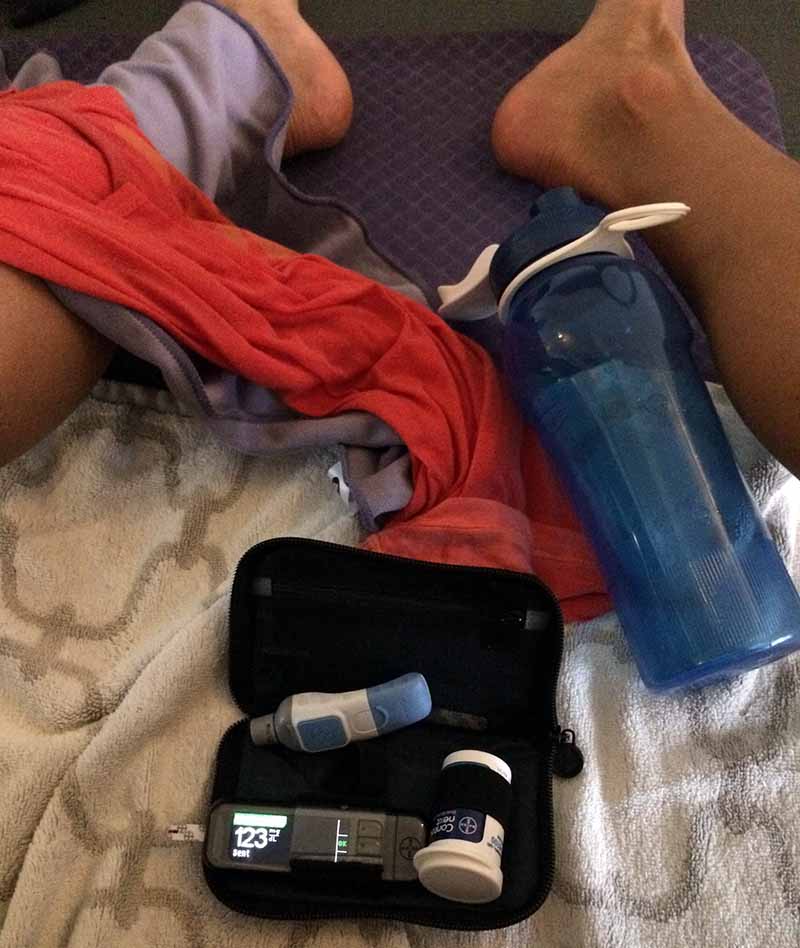I try to include yoga in my workout schedule whenever I can. It will never be my main type of workout (I love resistance training too much for that), but it’s a great addition to my normal routine.
Because I don’t do yoga that often, it’s taken me a little longer to figure out how to manage my blood sugar when on the yoga mat, especially because different types of yoga will affect my blood sugar in different ways.
Some yoga practices have you move through the poses super fast (making it almost a cardio workout) while others focus more on strength or meditation.
I’ve primarily taken Vinyasa and Bikram yoga classes so I’ll focus on how they impact my blood sugar and what strategies I implement to stay in my preferred blood sugar range.
Why yoga is great for people living with diabetes
What I like about yoga is that you spend 60-90 minutes focusing on your breathing, stretching, and, in the case of Bikram yoga, sweating.
The benefits of yoga are plentiful, and I have several friends within the diabetes community who practice yoga on a regular basis and they look and feel great.
The primary benefits of yoga that lured me in were the increased flexibility (something I need to continue working on) and the sense of relaxation afterward.
It can also help with reducing stress, thereby lowering cortisol levels, which is great for blood sugar management.
A further benefit of yoga is that you learn breathing and relaxation methods that can use every time life gets overwhelming.
How Vinyasa Yoga affects my blood sugar
Vinyasa yoga is the type of yoga you are most likely to encounter in mainstream gyms in the US. It’s typically a fairly quick flow of poses accompanied by coordinated breathing.
How inspiring the practice is and how it will affect blood sugars depend a lot on the instructor. Because Vinyasa doesn’t have a standardized set of poses, no two classes are ever alike. Vinyasa can be everything from a relaxing flow of poses all the way up to “power yoga” that will push your strength and endurance to the limit.
I’ve been in a few classes where the flow was very fast, making the blood sugar impact similar to what I’d expect from a cardio session, but most often, it’s a more slow-paced flow that only has a minor impact on my blood sugars.
So, if I know the type of flow the instructor is teaching, I’ll adjust my meal insulin bolus prior to the practice accordingly:
- If I expect it to be a fast-paced yoga flow (or don’t know what to expect), I’ll do a 25-30% bolus reduction with my last meal before the practice
- If I expect a slower flow, I’ll do a 0-20% reduction.
Of course, the exact reduction depends on what my blood sugar is before the workout. If it’s higher than want it to be, I will reduce my bolus less than normal.
I haven’t found that any post-yoga reductions in bolus or basal insulin is necessary. Yoga doesn’t affect my blood sugar for hours afterward like resistance training does.
How Bikram Yoga affects my blood sugar
Bikram yoga is different from Vinyasa since it’s a 90-minute class and takes you through the 26 different Bikram poses in a heated room.
I rather like the heated room (I tend to get cold very easily), but it can make blood sugar management harder because I can’t rely on the senses I usually rely on to tell me whether my blood sugar is running low.
The heat in the room makes me sweat and elevates my heart rate, which are my two main indicators of low blood sugar. Because of that, I am not sure I would feel it if my blood sugar was dropping during a Bikram yoga class. So for Bikram yoga, I’ll rely heavily on my CGM (Continuous Glucose Monitor).
The first time I tried Bikram yoga, I wasn’t wearing a CGM so I manually tested my blood sugars before we got started, after an hour, and then again after class. To my surprise, my sugars were…..perfectly stable (!). When class started, my blood sugar was 116 mg/dL (6.4 mmol/L) and after 90 minutes, it was 123 mg/dL (6.8 mmol/L). This was with a 20% bolus reduction before the class.
I had expected a larger impact on my blood sugar because of the heat and because the class was 90 minutes, but I have taken several other Bikram classes now and the result has always been the same.
Apparently, the Bikram classes I take simply don’t affect my blood sugar very much so, I’ve stuck with a ~20% bolus reduction for this type of yoga.

Conclusion
I enjoy both types of yoga, although I find Vinyasa a little more accessible. Vinyasa is usually only an hour or less and although your heart rate gets up, you don’t feel like you’ve taken a bath with your clothes on afterward.
Both types of yoga leave me feeling relaxed and in a good mood.
As with any other type of exercise, it’s important that you find your personal formula for food and insulin around your yoga classes (in collaboration with your medical team if needed).
I have found that yoga has a minimal effect on my blood sugar and that I only need a small (or no) reduction to my pre-yoga bolus, but it may be different for you.

